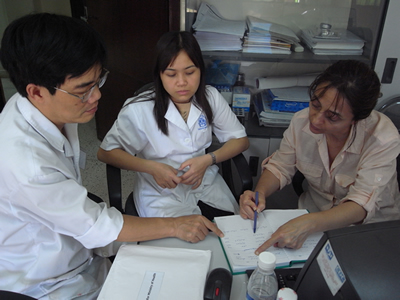In Viet Nam, Global Partnerships Help Change the Course of AIDS
July 2010 - Intent on turning the tide against the AIDS epidemic in Viet Nam, international donors began to support a massive expansion of HIV prevention, treatment, and care in 2004. Taking up the challenge presented by this dramatic funding increase, Viet Nam has established increasingly sophisticated HIV programs that have achieved a sixfold increase in antiretroviral therapy (ART) and doubled the number of HIV-positive pregnant women on treatment.
Although the epidemic continues to spread, particularly among injection drug users (IDUs) and men who have sex with men (MSM), the recent history of AIDS in Viet Nam illuminates some of the ways in which global partnerships can help change the landscape of public health.
From the earliest years of the epidemic in Viet Nam, HIV/AIDS has been concentrated within vulnerable populations. IDUs, for example, constitute up to 60 percent of the country's HIV-positive population. During the 1990s HIV prevalence rose sharply, yet the country lacked the resources to launch an aggressive campaign on its own against the epidemic. But this changed in 2004 when the U.S. partnered with Viet Nam under the umbrella of its global AIDS program, PEPFAR. In six years, the annual budget for HIV has increased 20-fold, to $120 million.

Dr. Bui Vu Huy (left) of Hanoi’s National Hospital of Pediatrics reviews patient records
for TREAT Asia’s pediatric HIV database with a member of his team and data manager Azar Kariminia.
|
"Having those resources has made a huge impact," said TREAT Asia Director Annette Sohn, M.D. "PEPFAR brought a concentration of scientific and technical resources to Viet Nam, including training for doctors, community organizations, and NGOs. And because core structures were being built that made expansion and success possible, other international donors came forward as well."
TREAT Asia's involvement in HIV research in Viet Nam began in 2005 when the National Hospital of Pediatrics in Hanoi and Children's Hospitals #1 and #2 in Ho Chi Minh City joined the newly formed TREAT Asia Pediatric Network. TREAT Asia has since expanded its research and education activities to include collaborations with five hospitals and two labs involving adult and pediatric clinical research, provider education, and laboratory quality assurance.
Dr. Bui Vu Huy of the National Hospital of Pediatrics in Hanoi attended TREAT Asia's annual network meeting for the first time in 2006 when it was held in Hanoi. "There we met many colleagues in other countries who had worked with us on other projects, including Professor Virat Sirisanthana from Chiang Mai University, who had been teaching me about HIV/AIDS since 1995," remembered Dr. Huy.
This year the National Hospital of Pediatrics is expected to join TREAT Asia's pediatric HIV observational database cohort along with two other hospitals. "In Viet Nam, doctors have conducted much HIV research in-country," said Dr. Huy, "but joining the TREAT Asia research collaboration will help us further these studies, which can have a big impact on the care and treatment of our patients."
TREAT Asia has recently begun conducting a physician education program in Viet Nam with the support of AusAID. In response to requests from local HIV/AIDS clinicians, TREAT Asia has organized three workshops on clinical epidemiology and research methods over the past eight months, with plans to expand these activities in the coming year.
Like many countries in the region, Viet Nam is now facing an uncertain future when it comes to ongoing international support for its HIV/AIDS programs. As the only PEPFAR focus country in Asia, it faces a significant challenge in determining how it will sustain treatment and infrastructure when PEPFAR begins to draw down its support. The growing involvement of Vietnamese clinical centers in research networks like TREAT Asia is creating links to technical support and facilitating collaborations that will help see their programs into the future.